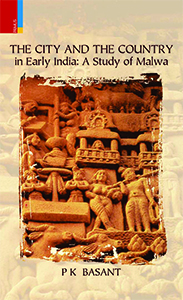
The City and the Country in Early India: A Study of Malwa
AUTHOR- P K Basant
| HB ₹1150 . $79.95 . ₤52.95 |
||
INFORMATION
- AUTHOR : P K Basant
- HB ISBN : 978-93-80607-15-3
- Year : 2012
- Extent : x + 370
- Discount available on checkout
- Usually dispatched within 3 to 5 working days.
The City and the Country in Early India
| HB ₹ 1150 . $ . ₤ |
PB ₹ . $ . ₤ |
|
| POD ₹ . $ . ₤ |
e-Book ₹ . $ . ₤ |
INFORMATION
- AUTHOR – P K Basant
- ISBN – 978-93-80607-15-3
- Year – 2012
- Extent: 400 + 40 coloured illustrations
- 10% discount + free shipping
- Usually dispatched within 3 to 5 working days.
The City and the Country in Early India: A Study of Malwa is about the emergence of urban centres in the sixth century bce, and analyses the processes and spatiality of urbanization, taking Malwa as its case study. Earlier research on urbanism has focussed on either literary or archaeological sources. While literary sources tend to locate the agency for change exclusively in preachers and rulers, in archaeology, the forces of change become nameless and faceless. The study of inscriptions from Malwa helps in restoring agency to common people.
The beginnings of urbanism are to be found in the pre-literate past, and, therefore, require an analysis of archaeological data. Using insights from anthropology and studies of early states, in the first half of the book an attempt has been made to look for new ways to account for urbanization.
The second half of the book tries to understand the process of urbanization by examining epigraphic and literary sources. The process of the emergence of urban centres created new forms of division of space: urban centres were surrounded by villages which in turn were surrounded by wilderness. This book tries to recover the histories of their complex interrelations. Since caste and kinship are considered central to the world of Indian sociology, an attempt has also been made to understand
the relationships between caste, kinship and urbanism. Changes in the attitude of the literati towards the city and the country have also been examined.
The Author
Dr P K Basant is Associate Professor of History at the Jamia Millia Islamia, New Delhi.
‘The effort is stupendous, the sweep is vast, the study is exhaustive, and the impact enlightening.’— HARBANS SINGH, The Tribune
The City and the Country in Early India: A Study of Malwa is about the emergence of urban centres in the sixth century bce, and analyses the processes and spatiality of urbanization, taking Malwa as its case study. Earlier research on urbanism has focussed on either literary or archaeological sources. While literary sources tend to locate the agency for change exclusively in preachers and rulers, in archaeology, the forces of change become nameless and faceless. The study of inscriptions from Malwa helps in restoring agency to common people.
The beginnings of urbanism are to be found in the pre-literate past, and, therefore, require an analysis of archaeological data. Using insights from anthropology and studies of early states, in the first half of the book an attempt has been made to look for new ways to account for urbanization.
The second half of the book tries to understand the process of urbanization by examining epigraphic and literary sources. The process of the emergence of urban centres created new forms of division of space: urban centres were surrounded by villages which in turn were surrounded by wilderness. This book tries to recover the histories of their complex interrelations. Since caste and kinship are considered central to the world of Indian sociology, an attempt has also been made to understand
the relationships between caste, kinship and urbanism. Changes in the attitude of the literati towards the city and the country have also been examined.
The Author
Dr P K Basant is Associate Professor of History at the Jamia Millia Islamia, New Delhi.
‘The effort is stupendous, the sweep is vast, the study is exhaustive, and the impact enlightening.’— HARBANS SINGH, The Tribune
Table of Contents
Table of Contents
| List Of Illustrations | ix-x |
| Acknowledgements | xi-xii |
| Introduction | 1-4 |
| Contextualizing The Problem | 5-33 |
| Urbanization: Problems Of Theory | 34-54 |
| Malwa: Face Of The Land | 55-76 |
| The Prehistory Of Urbanization In Malwa | 76-100 |
| The Beginning Of Political Society | 110-157 |
| Through The Gateways Of Sanchi: The Inscriptional Evidence | 158-192 |
| Sanchi: The Visual Evidence | 193-221 |
| The Emergence Of Malwa And Its Urban Centres: A View From Literature | 222-245 |
| Images Of The City And The Country In Early Indian Literature | 246-282 |
| Conclusion | 283-288 |
| Appendix I. List Of Sites With Archaeological Remains | 289-298 |
| Appendix II. A Classification Of The Inscriptions From Sanchi | 299-348 |
| Bibliography | 349-366 |
| Index | 367-369 |




